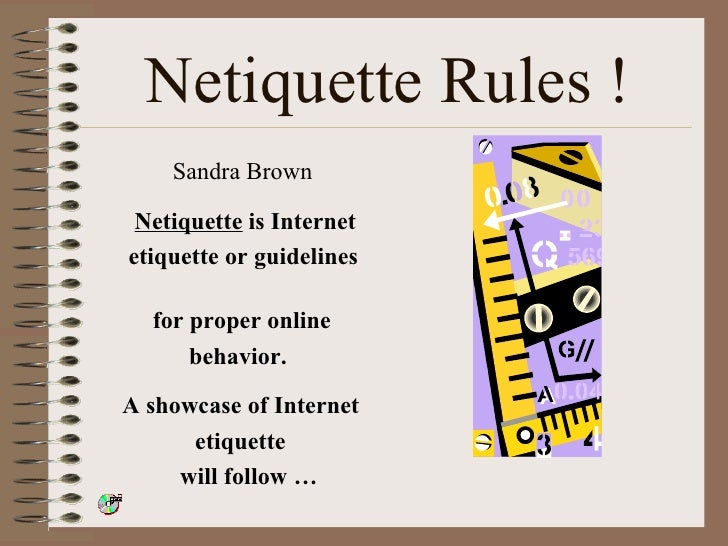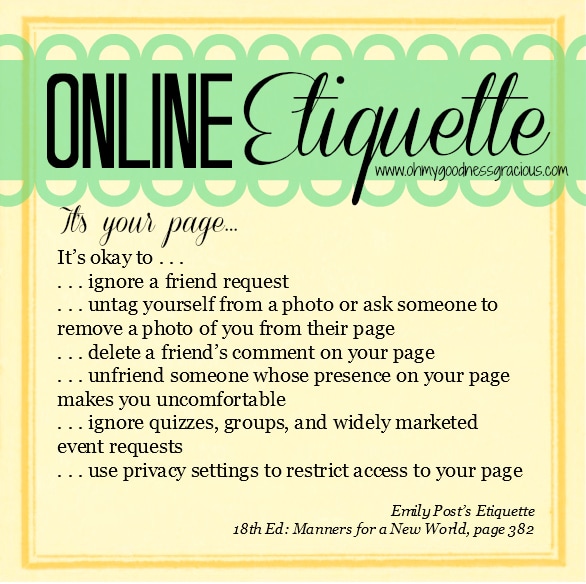

Prioritize and share content from verifiable, expert sources. Posting tone-deaf, inappropriate, profane, or unlawful content is one of the major social media mishaps you should avoid. Don’t post something that will embarrass you and make you look bad. Shea says to “ respect other people’s time and bandwidth.” This means users shouldn’t post content that doesn’t belong on a particular website or forum, nor should they post spam or needlessly long content. Different forums, websites, blogs, and social media platforms have varying community standards, which are often stated onsite. Be aware of context, and tailor your communications accordingly. Apply your normal standards of behavior to your behavior online. Remember there’s a human on the other side of your digital interaction, whether that interaction takes place on social media, email, or forum. According to Encyclopedia Britannica, netiquette is a set of “guidelines for courteous communication in the online environment.” Netiquette guidelines include rules for both social interaction and technical activities on the internet.Īlbion, the longest-running commercial site on the web, includes a resource on the core rules of netiquette, from Virginia Shea’s book, Netiquette. Netiquette is a portmanteau of network and etiquette. When it comes to cyberbullying and privacy, a good digital citizen follows something akin to the golden rule of the internet: when you engage with others online, treat them the way you want to be treated. They also know what a digital footprint is, and that visiting certain websites and downloading certain files compromises it. This includes efficacy - a digital citizen who adheres to best practices is able to use the internet effectively, for whatever lawful purpose, without compromising their security and that of others.Ī good digital citizen knows which types of websites, apps, and online interactions to stay away from, as well as what types of websites are reliable sources of information. 
What Does ‘Digital Citizenship’ Mean, and How Does It Apply to the Classroom?Īnn Collier of NetFamilyNews defines digital citizenship as, “Critical thinking and ethical choices about the content and impact on oneself, others, and one’s community of what one sees, says, and produces with media, devices, and technology.”Īs it applies specifically to the internet, digital citizenship is the set of best practices that describe how a person can navigate safely, ethically, and appropriately on the World Wide Web.

Educating a child on digital citizenship is a matter of relating the interest they already have with your knowledge on this important subject. Fortunately, kids are usually intrigued by the internet. To teach kids about digital citizenship, you must spark their interest and engage them in a dialogue. Students learn when they are engaged and thinking critically about the material. With proper education on the issues covered in this guide, students can learn about internet safety and may be better prepared to reap its benefits, while steering clear of the potential pitfalls.Īs a teacher or parent (or both), you know that an interactive dialogue with students is essential to education. Alternatively, the internet can be a great place for students to learn, get a jumpstart on the future, and connect with each other. The internet can be a dangerous place for students, where mistakes can have grave consequences.

Furthermore, we’ll cover digital property and copyright laws, with an emphasis on preventing plagiarism and encouraging fair use online.
DEFINITION OF NETIQUETTE HOW TO
You’ll learn how to teach safety and privacy in an online learning environment, and about cyberbullying and how to prevent it. Here, you’ll find the definition of “ digital citizenship” as well as its application in the classroom and beyond. The purpose of this resource is to provide teachers and parents with a guide for teaching digital citizenship and netiquette to students.








 0 kommentar(er)
0 kommentar(er)
